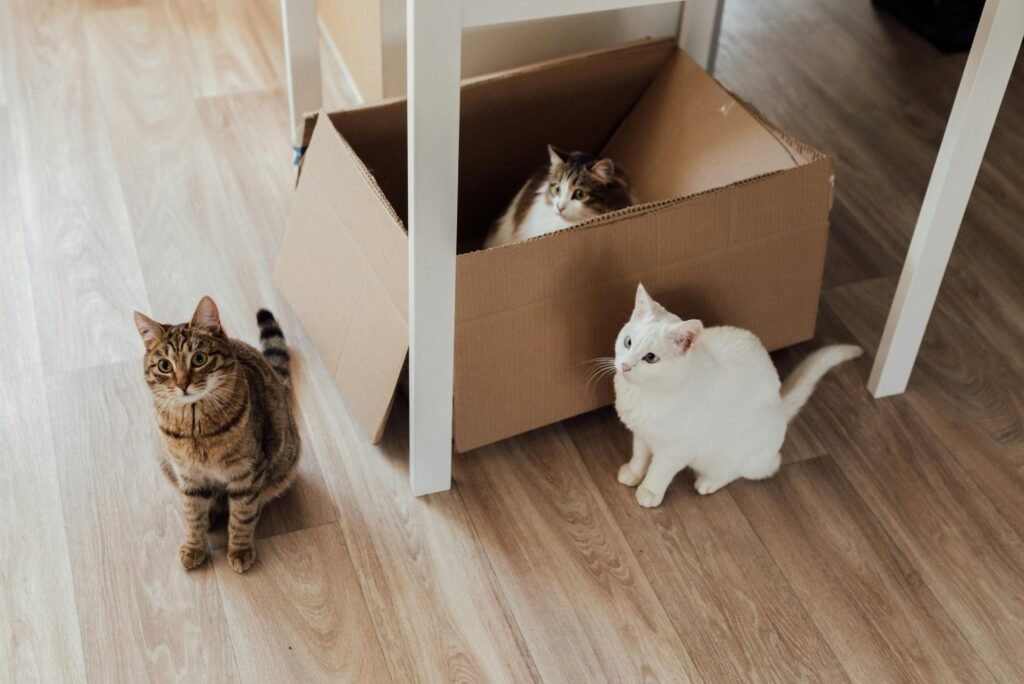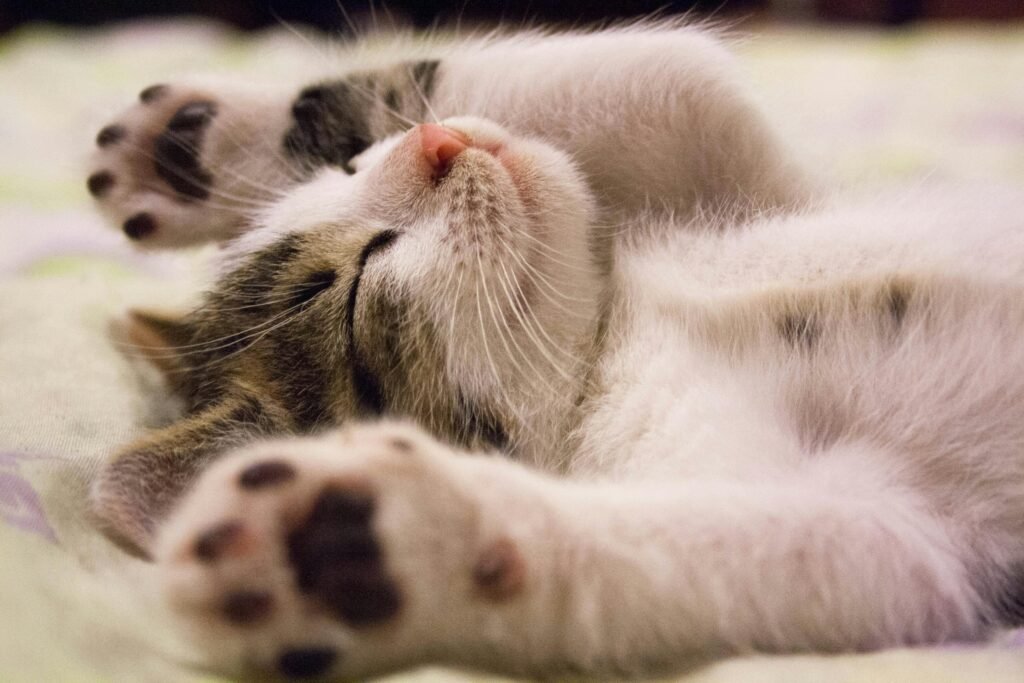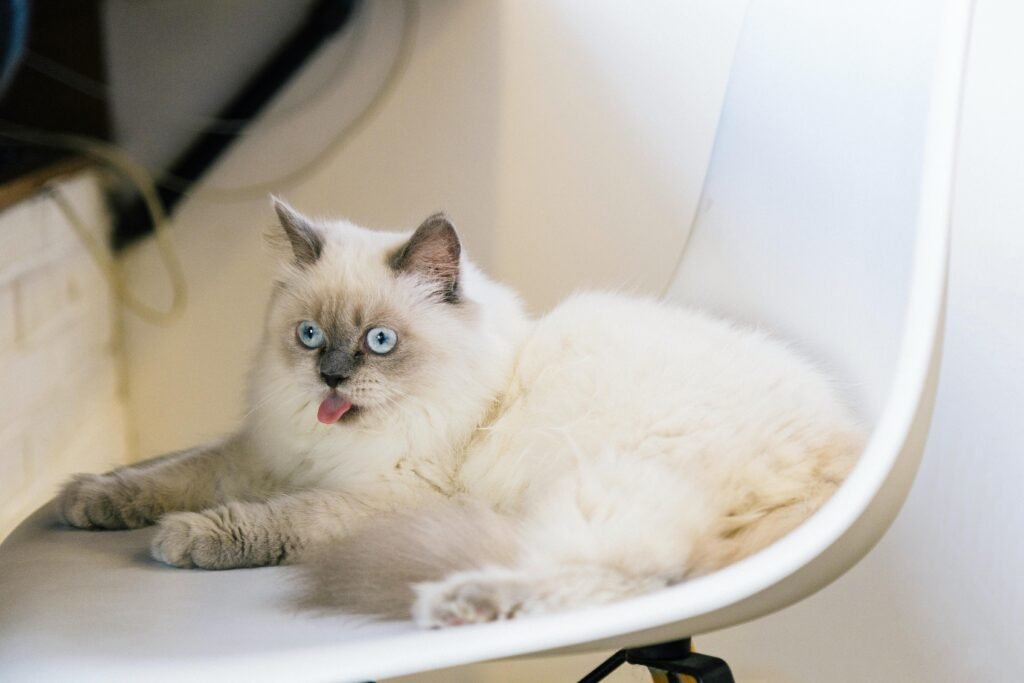Cats are more than pets – they’re family. Designing your home with your feline friend in mind can make life more comfortable for both of you. In this guide, we’ll explore cat-friendly home upgrades across the home and kitchen. From stylish litter box furniture to cat-safe cleaners, feeding stations, and furniture protectors, we cover the best improvements that benefit cat owners and their furry companions. We’ll also include product recommendations and expert tips on creating a safe, happy environment for your cat. Let’s dive in!
According to the ASPCA, creating a safe and enriching home environment is essential for a cat’s physical and emotional well-being. From the litter box to the kitchen, small upgrades can have a big impact on your cat’s comfort and your home’s cleanliness. In this guide, we’ll explore the smartest cat-friendly home upgrades every cat owner should consider.
Litter Box Furniture: Stylish & Discreet Solutions

One of the biggest challenges for cat owners is the litter box. An exposed litter box can be an eyesore and a source of unpleasant odors. Litter box furniture offers a clever solution by disguising the litter box as an attractive piece of furniture. These enclosures hide the box from view and contain litter scatter and odor. Your cat gets a private “bathroom” and you get a cleaner, fresher home. Most indoor cats actually prefer doing their business in private, so an enclosure appeals to their instincts. When choosing litter box furniture, measure your litter pan and your cat to ensure a comfortable fit. Look for designs with ventilation (to reduce smell) and easy access doors or panels for scooping. Place the furniture in a quiet, accessible spot so your cat feels secure using it.
Product Recommendations:
- Feandrea Cat Litter Box Enclosure – A stylish cabinet-style enclosure with barn doors. It blends into your decor as an end table and keeps litter mess and odor contained. The sturdy build and enclosed design give your cat privacy while also keeping curious dogs out.
- Good Pet Stuff Hidden Litter Box Planter – A clever litter box hidden inside a faux planter. It features a decorative outer pot with a ventilated lid and an artificial plant on top. This design conceals the litter box in plain sight and provides ample room inside for large cats. It’s made of durable polypropylene that resists stains and odor.
Buying Tip: Introduce new litter box furniture gradually. Let your cat explore it without the litter at first, or place it around the existing box, so they get comfortable. Keep the interior clean (scoop daily and refresh litter often) to ensure your cat continues to use the enclosure happily. A well-designed litter box cabinet with a door and litter catch tray can significantly reduce tracked litter and odor in your home, making life easier for you and more pleasant for your cat.
Cat-Safe Cleaners: Non-Toxic Cleaning Solutions

A clean home is important, but not at the expense of your pet’s health. Many common cleaning products (bleach, ammonia, etc.) contain chemicals that can irritate or even poison cats. Cats walk on floors and surfaces then groom themselves, so any residue can be ingested. The solution is to use cat-safe cleaners – products formulated to be non-toxic around animals. Look for keywords like “pet-safe,” “non-toxic,” or enzymatic cleaners (which use natural enzymes to break down pet messes). Enzymatic cleaners are highly effective for pet stains and odors and are biodegradable and non-toxic, meaning they’re safe to use on any surface your cat might contact. These are great for cleaning up urine, vomit, or other accidents without harsh chemicals.
When cleaning, it’s wise to keep your cat out of the area until surfaces are dry and any fumes dissipated. Even pet-safe products should be used with ventilation. Avoid cleaners with chlorine, formaldehyde, phthalates, phenols, or other known toxins. If you’re unsure, simple DIY solutions like diluted white vinegar or baking soda can handle many cleaning jobs and are generally safe for pets. Store all cleaning supplies in cabinets with child-proof latches so your cat can’t accidentally get into them. Better yet, opt for natural or green cleaning products to minimize any risk.
Product Recommendations:
- Nature’s Miracle Stain & Odor Remover – A popular enzymatic cleaner that effectively removes pet urine, feces, vomit, and other organic stains. It leaves behind a light, fresh scent and breaks down odors at the source rather than masking them. Safe to use on carpets, hardwood, furniture, and fabrics (always follow instructions).
- Angry Orange Pet Odor Eliminator – A powerful citrus-based deodorizer for strong pet odors. Originally developed for farms, this concentrate (or ready-to-use spray) tackles cat urine smells on floors, litter boxes, and upholstery. It’s non-toxic to pets and humans when used as directed, and the pleasant orange scent helps freshen the area.
Usage Tip: Always do a spot test when using a new cleaner on fabric or flooring. Even pet-safe cleaners should be tested on a small area to ensure they don’t cause discoloration. When cleaning litter boxes or food bowls, avoid harsh chemicals entirely – use mild dish soap and hot water instead. Keeping up with regular cleaning (vacuuming pet hair, washing pet bedding, wiping up accidents promptly with an enzymatic cleaner) will maintain a healthier home environment for both you and your cat.
Feeding Stations: Better Dining for Your Cat
Upgrade your cat’s dining area with a well-thought-out feeding station. This could mean anything from an elevated bowl set to an automatic feeder or a drinking fountain. Standard cat bowls on the floor can be messy – kibble gets scattered and water spills. By contrast, raised feeding stations keep things tidy and have health benefits. Elevated cat bowls allow your cat to eat in a more natural posture, which can reduce neck strain and improve digestion. Older cats or those with arthritis especially benefit from not having to crouch low to eat. Many vets and pet experts also note that raised feeders may help reduce vomiting in cats who gulp food, and even minimize “whisker fatigue” by using wide, shallow bowls in an elevated stand.
Consider a feeding station that includes a mat or tray to catch crumbs and water drips. This protects your floors and makes cleanup easier. If you have a dog in the household who likes to raid the cat’s food, an innovative solution is a wall-mounted cat feeder shelf. By mounting the feeding station at a height the dog can’t reach, your cat can dine peacefully out of the dog’s reach. Multi-level cat furniture or a simple shelf in the kitchen can serve this purpose – “set the shelves up at a height your dog can’t reach and your cat has a stress-free eating experience”.
Another worthwhile upgrade is an automatic cat feeder. These devices dispense pre-portioned meals on a schedule, which is a lifesaver for early mornings, busy workdays, or controlling your cat’s weight. A programmable feeder ensures your cat never misses a meal, even if you’re not home. Many models have tamper-proof designs (important for clever cats who might try to break into the kibble storage) and battery backup in case of power outages. Automatic feeders help prevent overfeeding by measuring exact portions, and some even allow voice recording to call your cat at mealtime. For water, cats often prefer running water sources. A pet water fountain provides filtered, circulating water that encourages cats to drink more (great for their kidney health) – plus you won’t have to constantly refill a bowl. Stainless steel or ceramic fountains are ideal as they are easy to clean and resist bacterial growth.
Product Recommendations:
- Neater Feeder Cat Feeding Station – An elevated feeder with built-in mess containment. This raised bowl setup has a patented design where any spilled water drains into a lower catch basin and spilled food stays on top for easy cleanup. The stainless steel bowls are shallow and whisker-friendly, and the platform is just the right height (about 3 inches) for cats. It’s great for tidy floors and comfortable feeding.
- PETLIBRO Automatic Cat Feeder (5L) – A highly-rated automatic feeder that lets you program multiple meals per day with precise portion control. It features a large 5-liter hopper with a desiccant to keep kibble fresh and a secure lid to prevent spills or sneaky snacking. You can even record a 10-second voice message to call your cat when it’s feeding time. Many cat owners use this to manage diet or feed their cat while at work.
- Catit Flower Water Fountain (3L) – A popular circulating water fountain for cats. It has a fun flower design that offers different flow settings (gentle fountain or bubbling top) to suit your cat’s preference. The fountain holds 3 liters of water and includes a triple-action filter to remove impurities and keep the water fresh. Cats are attracted to the flowing water, which can significantly increase their water intake. The unit is easy to assemble and clean, with replaceable filters available.
Buying Tips: For elevated feeders, choose one proportional to your cat’s height (the bowl rim at roughly chest level). Ensure water fountains and feeders are cleaned regularly to prevent biofilm or mold – most have parts that are dishwasher safe or easy to hand wash. If you use an automatic feeder, check it periodically to confirm it’s dispensing properly and replace batteries as needed. Some tech-savvy feeders even connect to smartphone apps for remote monitoring. Whatever feeding station you set up, keep it in a calm, low-traffic area of your home so your cat feels comfortable eating and drinking there. Cats like routine, so try not to move their feeding station around once they’re used to it.
Furniture Protectors: Save Your Couch (and Your Sanity)

Cats need to scratch – it’s normal, healthy behavior that helps them stretch and maintain their claws. However, that natural instinct can wreak havoc on your furniture. Furniture protectors allow you to redirect your cat’s scratching in a constructive way while shielding your sofa, chairs, and drapes from damage. There are a variety of options to consider:
- Scratching post or pad near the furniture: Often the simplest solution is to provide an appealing scratcher right next to the spot your cat likes to scratch. A tall, sturdy cat scratching post (covered in sisal rope or carpet) near the couch can draw your cat’s attention away from the couch arm. You can also use horizontal scratch pads if your cat prefers those – many cats like having both horizontal and vertical options. Encourage use by sprinkling catnip on the scratcher and praising your cat when they use it.
- Sisal furniture wraps: These are protectors made of natural sisal fiber or heavy-duty fabric that you can wrap or drape over parts of your furniture. For example, a sofa arm scratch shield made of woven sisal covers the entire arm of a couch, giving your cat a legal scratching zone. The sisal is tough enough to withstand claws and satisfies your cat’s need to scratch, all while preventing any damage to the couch underneath. Look for products that cover a large area and attach securely (some slip over the arm, others tie or Velcro on). As cat behaviorist Dr. Janet Cutler advises, “get something that covers the entire piece of furniture so they don’t just move to another spot… and a thick material that your cat can’t scratch through”.
- Clear vinyl guards and tapes: Transparent adhesive shields are another popular choice. These are plastic sheets or double-sided tape strips that you apply directly to the furniture. Cats dislike the sticky or smooth texture, which deters scratching. For example, furniture tape creates a sticky feeling on the spots your cat tries to claw, training them to avoid those areas. Clear vinyl couch protectors can be draped over an entire sofa or particular sections; the slick surface won’t feel pleasant under a cat’s claws. These solutions are usually temporary training aids – once your cat learns that the couch is no fun to scratch, you can remove them. (Always monitor that your cat isn’t ingesting any pieces of tape or plastic if you use these guards.)
- Furniture covers and washable throws: If your main concern is fur, spills, or scratches on surfaces, consider using machine-washable slipcovers or throws on your furniture. A snug-fitting slipcover made of durable, tight-woven fabric can protect the upholstery beneath. This won’t stop a determined cat from scratching, but it can minimize damage and is easier to clean (just toss it in the wash) when it gets covered in fur or pet grime.
Along with protectors, claw maintenance is key: keep your cat’s nails trimmed regularly to lessen the damage of any scratching. You can also use nail caps (soft vinyl caps that glue onto your cat’s claws) as a temporary measure, though not all cats tolerate them. Most importantly, provide appropriate scratching posts in multiple locations so your cat has plenty of outlets. Positive reinforcement when they use the post – and gentle deterrence when they go for the couch – will train them over time. Never declaw your cat as a solution; instead, use these humane approaches to protect your furniture.
Product Recommendations:
- Navaris Cat Scratch Sofa Shield – A sisal scratch mat designed to protect couch sides or arms. This woven sisal mat drapes over the side of your sofa (available in left or right side versions) and secures by tucking in and tying. The natural sisal fiber is durable and gives your cat a satisfying texture to claw at, saving the actual couch fabric. It comes in neutral colors to blend with home decor.
- Sofa-Scratcher Cat Couch Corner Post – An ingenious scratching post that attaches to the corner of your sofa. It’s a 24-inch tall post covered in sisal carpet that wraps around the couch corner where cats often love to scratch. The base slides neatly under the couch leg for stability. By positioning this right on the couch corner, it protects that vulnerable area and redirects your cat to scratch the post instead. Many reviewers note it’s effective and cats took to it immediately.
Tips: For stubborn scratchers, a small squirt of a pet-safe deterrent spray on the furniture (something with a bitter or citrus scent that cats dislike) can reinforce the message. Simultaneously, make the new scratching post super inviting – use catnip, interactive toys, or treats on it to draw interest. Consistency is key: if you see your cat scratching the couch, calmly redirect them to the scratcher every time. Over a few weeks, they’ll learn what’s theirs to scratch. Remember that scratching is healthy for cats (it relieves stress and helps mark territory), so our goal isn’t to stop scratching altogether, but to guide it to appropriate places. With the right furniture protectors and training, you can save your sofa without depriving your cat of their natural behavior.
Tips for Designing a Cat-Friendly Home and Kitchen
Upgrading your home for a cat doesn’t end with products – it’s also about making mindful design choices. Here are some expert tips for creating a cat-friendly home (especially in high-use areas like the kitchen) while still keeping things stylish and safe:
- Create Vertical Spaces: Cats love to climb and observe their territory from above. Incorporate some vertical elements like cat wall shelves, window perches, or a tall cat tree so your kitty can perch up high. This not only enriches their environment but also expands their territory vertically, which is great for their mental stimulation and can reduce conflicts in multi-cat homes. In the kitchen, you might set up a cushioned window seat or the top of a sturdy cabinet as a designated cat hangout, so they can watch you cook without walking on the counters.
- Secure Potential Hazards: Cat-proofing is similar to baby-proofing. Use child-proof latches on lower cabinets, especially where you store cleaning supplies or trash cans. This prevents curious paws from prying doors open. Store toxic substances out of reach or in locked cabinets. Common kitchen items like certain cleaners, pesticides, or even foods (chocolate, alcohol, etc.) can be dangerous if ingested, so it’s vital they stay inaccessible. A covered trash can or a pull-out trash bin inside a cabinet will keep cats (and dogs) from dumpster-diving.
- Opt for Pet-Friendly Materials: When choosing furniture or finishes, keep your cat in mind. Floors that are scratch-resistant and easy to clean (tile, laminate, sealed hardwood) will hold up better to claws and the occasional accident. For sofas and chairs, avoid high-pile or loosely woven fabrics that claws can snag. Instead, choose tight-weave materials like microfiber or leather, which are tougher for cats to shred and easier to wipe clean of fur. “If your pet loves to scratch, avoid high-pile, textured fabrics and opt for a dense or tight weave fabric like microfiber instead.” Also consider machine-washable slipcovers on sofas, so you can easily launder out fur and odors.
- Think About Surfaces and Decor: Cats will explore every surface. To protect your valuables and maintain hygiene, design your space accordingly. In the kitchen, keep counters and stovetops clear or use deterrents to train your cat to stay off. (One effective training method: placing double-sided tape or sticky mats on counters – cats dislike the tacky feel and will avoid the area.) Always cover stove burners (especially if they’re hot) and be cautious with open flames from candles or gas stoves when pets are around. In living areas, anchor wobbly furniture and bookshelves to the wall to prevent tip-overs if your cat jumps on them. Store delicate decor or heirlooms behind glass or in rooms the cat can’t access, so a playful swipe of the paw doesn’t send your collectibles crashing.
- Eliminate Toxic Plants and Pests: Houseplants can improve air quality and aesthetics, but make sure any plants you keep are non-toxic to cats. Many common plants (lilies, azaleas, philodendrons, etc.) are poisonous if a cat chews on them. Opt for cat-safe greens like spider plants, Boston ferns, or cat grass. Likewise, avoid using rodent poisons or insect traps that your cat could get into. Use pet-safe pest control methods instead.
- Make It Cozy: Designate cat-specific zones throughout your home. Cats appreciate having safe, cozy hideaways to retreat to. This could be a cat bed tucked in a quiet corner, a blanket on a shelf, or even a decorative “cat teepee” or tent in the living room. Providing these havens can reduce stress for your cat. In the kitchen, if you have space, set up a small cat nook – for example, a soft bed on a countertop away from food prep areas, where your cat can lounge and watch the household hubbub without being shooed away. Teaching them that this spot is okay, while the dinner table is not, creates boundaries both of you can live with.
- Safety First: Always keep an eye on appliances. Cats are notorious for investigating dryers, washing machines, dishwashers, even refrigerators. Develop a habit of checking inside these appliances before closing the door. Keep toilet lids down to prevent accidents (and to stop cats from drinking the water). If you have open windows, ensure there are sturdy screens installed – many cats have fallen from high-rise windows (“high-rise syndrome”) by pushing through loose screens or unnoticed openings. In the kitchen, be mindful of cookware: cats could jump on a hot stove or lick something toxic. It might be wise to keep cats out of the kitchen while cooking, by using a baby gate or closing the door, especially if you’re frying or baking (the smell can attract them to dangerous areas). Good ventilation (use that range hood) will also clear out fumes that could be irritating to your pet.
By incorporating these tips, you’ll create a home that is welcoming for your cat without sacrificing your personal style or cleanliness. Many of these adjustments are simple (like moving a plant or adding a slipcover) but can make a big difference in preventing problems. A truly cat-friendly home is one where your feline has places to play, rest, eat, and eliminate comfortably – and you have peace of mind knowing your belongings are safe and your pet is happy. It’s all about finding that balance. 🐱🏠
Looking for more pet tips? Check our post Find the Best Home and Kitchen Essentials for Dog Owners.
FAQ
Q: How can I stop my cat from scratching the furniture?
A: The key is to redirect your cat’s scratching to an appropriate place and make the furniture unappealing to scratch. Start by providing one or more sturdy scratching posts or scratch pads near the areas your cat likes to scratch. Encourage your cat to use them by sprinkling catnip on the post or playing with toys around it. Simultaneously, protect your furniture with covers or scratch guards – for example, use a sisal wrap on the couch arm or apply clear adhesive anti-scratch tape, which creates a sticky texture cats dislike. Whenever you catch your cat scratching the furniture, never punish them physically (they don’t understand and it causes stress). Instead, gently redirect them to the scratcher and praise them when they use it. You can also temporarily block access to favorite scratching spots (with furniture rearrangement or a fitted cover) until the habit decreases. Regularly trim your cat’s nails to minimize damage, and consider nail caps if needed. With patience and consistency, your cat can be trained to leave the sofa alone and use the scratching post instead.
Q: How do I keep my cat off the kitchen counters?
A: Cats are curious climbers, so it’s a common challenge. First, try to remove the temptation: keep food securely stored so counters aren’t so intriguing as hunting grounds. Clean up spills and crumbs promptly. Next, make the counters less inviting. One proven method is using double-sided tape or sticky mats on the counter surface when you’re not using it – cats hate the sticky feeling on their paws and will learn to avoid those areas. Aluminum foil or crinkly plastic sheets can also deter cats (they dislike the texture and sound). Another tactic is to place lightweight cookie sheets near the edge; when a cat jumps up, the sheets fall and make a scary noise (just be sure it’s harmless noise, not something that could hurt them). Importantly, provide an alternative: cats often jump up because they want a higher vantage point or to be near you. So, give your cat a perch near the kitchen – like a cat tree in the corner or a window seat – where they can supervise at a safe distance. Reward them for using that spot. If you consistently shoo them off and reward them for staying on their designated perch, they’ll get the message. Finally, never leave dangerous items on counters or stovetops. If your cat is especially persistent, consider restricting access to the kitchen with a pet gate or closed door when you’re cooking or away. Patience and consistency are key; over time your cat can learn that counters are off-limits.
Q: Will my cat actually use a litter box enclosure (hidden litter box furniture)?
A: Most cats take to litter box enclosures quite well, as long as the enclosure is designed with the cat’s needs in mind. Cats value privacy when doing their business, and an enclosure provides a quiet, hidden nook for them. The enclosure also helps contain odors and litter scatter, which pet owners love. To ensure your cat is comfortable, choose an enclosure that is large enough for them to turn around in and enter/exit easily. It should have at least one large opening or a clear doorway. Many enclosures have ventilation slots or fans – good airflow is important so smells don’t build up (some come with carbon filters as well). When you first get the enclosure, place your cat’s current litter box inside it (if possible) so the setup is familiar. If the enclosure has a door, you might prop it open initially until your cat is confidently going in and out. Keep the litter box very clean; a dirty box (hidden or not) can cause a cat to avoid it. If you notice any hesitation, try a different style of enclosure – some cats prefer front entry, others top-entry, etc. Also consider your cat’s mobility: very elderly or large cats might prefer an enclosure with a low entryway. In general, though, cats appreciate the privacy and many owners find their felines use an enclosed litter box readily, with the bonus that your home looks nicer without a litter tray in plain sight.
Q: Are automatic feeders and fountains a good idea for cats?
A: Yes, automatic feeders and water fountains can be very useful for cat owners and are generally safe and beneficial for cats when used properly. Automatic feeders are great for portion control and maintaining a feeding schedule. If you work irregular hours or want to prevent those 5 AM wake-up meows for breakfast, an automatic feeder ensures your cat gets fed at the same times each day. This consistency is good for their digestion and prevents overeating by doling out measured meals. It can also help cats who need small, frequent meals (you can schedule multiple small feedings). Modern automatic feeders have features like backup batteries, secure lids, and even Wi-Fi/App connectivity, so they are quite reliable – just make sure to keep it clean and check that it’s dispensing correctly (some models can jam with larger kibble). Water fountains are beneficial because cats tend to drink more from flowing water. Many cats are drawn to the sound or movement of a fountain, which can help keep them hydrated (important for urinary health, especially for males or if your cat eats dry food). Fountains usually have filters to keep the water tasting fresh. The main responsibility with a fountain is to clean it regularly (slimy biofilm can develop otherwise) and replace the filters as directed. Overall, these gadgets are convenient and can enrich your cat’s routine. However, they shouldn’t be a 100% substitute for human attention – you still need to observe your cat’s eating/drinking habits to catch any issues (like if they’re not eating due to illness). And if you go away for more than a day or two, it’s wise to have a pet sitter check on your cat even if you use an auto-feeder, just for safety. Used correctly, automatic feeders and fountains make life easier and keep your kitty well-fed and watered around the clock.
Q: What sofa fabric is best if I have cats?
A: The best couch fabrics for cat owners are ones that are durable, tightly woven, and easy to clean. Microfiber (microsuede) is often cited as an excellent choice – it has a smooth, tight weave that cats find harder to sink their claws into, and fur doesn’t stick as much compared to textured fabrics. Microfiber is also pretty stain-resistant and can be spot-cleaned or sometimes even machine-washed if the covers are removable. Leather (or faux leather) is another decent option: it’s not snag-prone and fur can be wiped off easily; however, leather can show scratch marks if a cat does dig in, so it works best with cats who aren’t heavy scratchers or if you keep their nails trimmed. Avoid fabrics with loose weaves or thick loops, like tweed or boucle – claws can catch on the threads and cause pulls, and those fabrics are like magnets for fur. Also skip high-pile materials like chenille or velvet with a nap; while some cats actually don’t like the feel of velvet and leave it alone, others might damage it. A general rule from upholstery experts: “if your pet loves to scratch, avoid high-pile, textured fabrics and opt for a dense or tight weave fabric like microfiber instead.” In addition, look for couches labeled as having performance fabric or pet-friendly fabric. These often have built-in stain resistance and higher durability ratings (measured in double rubs). Lastly, consider using throws or slipcovers on areas your cat frequents – it’s much easier to wash a cover than to deep clean a whole couch. By choosing the right material and providing your cat with scratching alternatives, you can have nice furniture that coexists with your feline friend.
By implementing the home upgrades and tips above, you can create a living space that both you and your cat will love. A bit of planning and a few smart products go a long way in preventing messes and mischief. The result is a happier cat, a cleaner home, and a more harmonious life together. Enjoy your cat-friendly home makeover! 🏡😺













